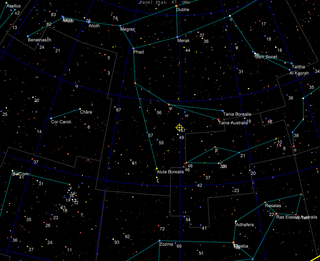| Observation data Epoch J2000.0 Equinox J2000.0 | |
|---|---|
| Constellation | Ursa Major |
| Right ascension | 10h 59m 27.9728s[1] |
| Declination | +40° 25′ 48.921″[1] |
| Apparent magnitude (V) | +5.03 |
| Characteristics | |
| Spectral type | G1V |
| U−B color index | 0.13 |
| B−V color index | 0.61 |
| Astrometry | |
| Radial velocity (Rv) | 11.24(12)[1] km/s |
| Proper motion (μ) | RA: −316.850(97) mas/yr[1] Dec.: 55.180(118) mas/yr[1] |
| Parallax (π) | 72.0070 ± 0.0974 mas[1] |
| Distance | 45.30 ± 0.06 ly (13.89 ± 0.02 pc) |
| Absolute magnitude (MV) | 4.41[2] |
| Details | |
| Mass | 1.08[3] M☉ |
| Radius | 1.172 ± 0.111[4] R☉ |
| Luminosity | 1.48[note 1] L☉ |
| Surface gravity (log g) | 4.377[3] cgs |
| Temperature | 5,887 ± 3.8[5] K |
| Metallicity | 110% solar[3] |
| Rotational velocity (v sin i) | 2.80[3] km/s |
| Age | 6.03[6] Gyr |
| Other designations | |
| Database references | |
| SIMBAD | The star |
| planet b | |
| planet c | |
| planet d | |
| Exoplanet Archive | data |
| ARICNS | data |
47 Ursae Majoris (abbreviated 47 UMa), formally named Chalawan /ˈtʃɑːləwən/,[7][8] is a yellow dwarf star approximately 45.3 light-years[1] from Earth in the constellation of Ursa Major. As of 2011[update], three extrasolar planets (designated 47 Ursae Majoris b, c and d; the first two later named Taphao Thong and Taphao Kaew) are believed to orbit the star.
The star is located fairly close to the Solar System: according to astrometric measurements made by the Gaia space observatory, it exhibits a parallax of 72.0070 milliarcseconds, corresponding to a distance of 45.30 light-years.[1] With an apparent magnitude of +5.03, it is visible to the naked eye and its absolute magnitude of +4.29 implies a visual luminosity around 60% greater than the Sun. A solar analog, with a spectral type of G1V, it has a similar mass to that of the Sun but is slightly hotter at around 5,882 K.[3] and slightly more metal-rich with around 110% of the solar abundance of iron.
Like the Sun, 47 Ursae Majoris is on the main sequence, converting hydrogen to helium in its core by nuclear fusion. Based on its chromospheric activity, the star may be around six billion years old, though evolutionary models suggest an older age of around 8.7 billion years.[6] Other studies have yielded estimates of 4.4 and 7 billion years for the star.[9] The low level of magnetic activity makes it a Maunder Minimum candidate star.[10]
- ^ a b c d e f g Cite error: The named reference
GaiaDR3was invoked but never defined (see the help page). - ^ Cite error: The named reference
aaa343_222was invoked but never defined (see the help page). - ^ a b c d e "Stars Table". Catalog of Nearby Exoplanets. Archived from the original on 17 October 2008. Retrieved 2008-10-04.
- ^ G. T. van Belle; K. von Braun (2009). "Directly Determined Linear Radii and Effective Temperatures of Exoplanet Host Stars". Astrophysical Journal. 694 (2): 1085–1098. arXiv:0901.1206. Bibcode:2009ApJ...694.1085V. doi:10.1088/0004-637X/694/2/1085. S2CID 18370219.
- ^ V. V. Kovtyukh; Soubiran, C.; et al. (2003). "High precision effective temperatures for 181 F-K dwarfs from line-depth ratios". Astronomy and Astrophysics. 411 (3): 559–564. arXiv:astro-ph/0308429. Bibcode:2003A&A...411..559K. doi:10.1051/0004-6361:20031378. S2CID 18478960.
- ^ a b C. Saffe; Gómez, M.; et al. (2005). "On the Ages of Exoplanet Host Stars". Astronomy and Astrophysics. 443 (2): 609–626. arXiv:astro-ph/0510092. Bibcode:2005A&A...443..609S. doi:10.1051/0004-6361:20053452. S2CID 11616693.
- ^ "IAU Catalog of Star Names". Retrieved 28 July 2016.
- ^ Thai Astronomical Society, Chalawan, Taphao Thong, Taphao Kaew – First Thai Exoworld Names
- ^ E. E. Mamajek; L. A. Hillenbrand (2008). "Improved Age Estimation for Solar-Type Dwarfs Using Activity-Rotation Diagnostics". Astrophysical Journal. 687 (2): 1264–1293. arXiv:0807.1686. Bibcode:2008ApJ...687.1264M. doi:10.1086/591785. S2CID 27151456.
- ^ Cite error: The named reference
Lubin_et_al_2012was invoked but never defined (see the help page).
Cite error: There are <ref group=note> tags on this page, but the references will not show without a {{reflist|group=note}} template (see the help page).
